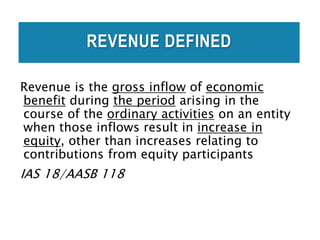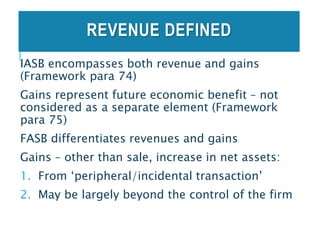Revenue
- 1. LECTURE 9 REVENUE ARTHIK DAVIANTI, SE. MSI. AK. CA.
- 2. REVENUE DEFINED Revenue is the gross inflow of economic benefit during the period arising in the course of the ordinary activities on an entity when those inflows result in increase in equity, other than increases relating to contributions from equity participants IAS 18/AASB 118
- 3. REVENUE DEFINED Income is increases in economic benefits during the accounting period in the form of inflows or enhancements of assets or decreases of liabilities that result in increases in equity, other than those relating to contributions from equity participants. AASB Framework
- 4. REVENUE DEFINED Revenues are inflows or other enhancement of assets or an entity or settlements of its liabilities (or a combination of both) during a period from delivering or producing goods, rendering services, or other activities that constitute the entity’s on going major or central operation FASB Framework
- 5. REVENUE DEFINED PSAK No.23: “ Kenaikan manfaat ekonomi selama suatu periode akuntansi dalam bentuk pemasukan atau penambahan aset, atau penurunan liabilitas yang mengakibatkan kenaikan ekuitas yang tidak berasal dari kontibusi penanam modal”
- 6. REVENUE DEFINED Revenue represents a physical and a monetary flow Revenue is an inflow of economic benefits Revenue forms part of income – which also includes gains – and arises in the course of ordinary activities Examples are sales, fees, interest, dividends, royalties and rents
- 7. REVENUE DEFINED IASB encompasses both revenue and gains (Framework para 74) Gains represent future economic benefit – not considered as a separate element (Framework para 75) FASB differentiates revenues and gains Gains – other than sale, increase in net assets: 1. From ‘peripheral/incidental transaction’ 2. May be largely beyond the control of the firm
- 8. BEHAVIOURAL VIEW OF REVENUE Revenues are the result of firm activity Net accomplishment of firm revenue = accomplishment expense = effort matching results in profit = net accomplishment A point of recognition must be determined critical event accrual throughout earnings process
- 9. BEHAVIOURAL VIEW OF REVENUE General business operation Bedford (1965) 1. Acquisition of money resources 2. Acquisition of services 3. Use of services 4. Recombination of acquire services 5. Disposition of services 6. Distribution of money resources
- 10. BEHAVIOURAL VIEW OF REVENUE The critical event and recognition of net profit, Myers (1959): Certain critical events and decisions made by the managers of the firm Profit is earned at the moment of making the most critical decision or of performing the most difficult task in the cycle of a complete transaction. Depending on the nature of the business
- 11. BEHAVIOURAL VIEW OF REVENUE Historical perspective Profit (and revenue) determined on the basis of the increase in the net worth of the firm Through a policy of replacement accounting or by the way of periodic asset appraisal (Chatfield, 1962) A review of accounting, legal and economic writing suggest that the realisation postulate was not accepted prior to WW I – agreement on the ‘increase of net worth’ in 1913 (May, 1950)
- 12. REVENUE RECOGNITION Great depression in 1930 – abuses of appraisal valuation in 1920s The first authoritative use of the word ‘realization’ in 1932 (Chatfield, 1962) Supplanted by the notion that profit and revenue had to be realised Developed into the revenue recognition principle (or realisation principle) A distinction between capital and profit emerged from court rulings
- 13. CRITERIA FOR REVENUE RECOGNITION At what point during the earning process can revenue be recorded as earned because there is sufficient evidence?
- 15. CRITERIA FOR REVENUE RECOGNITION Recognition criteria are based on the desire for both relevant and reliable accounting information: 1. measurability of asset value 2. existence of a transaction 3. substantial completion of the earning process
- 16. REVENUE MEASUREMENT Framework – provides 2 criteria for revenue recognition – it is probable that any future economic benefit associated with the item will flow to or from the entity – the item has a cost or value that can be measured with reliability Revenue recognition is not straightforward because of the wide range of different business revenue-generating activities and circumstances
- 17. REVENUE MEASUREMENT • The need for reliable or verifiable measurement – conservative approaches to valuing assets. • Asset valuation to be recorded when actually realised. IAS 18/AASB 118 Revenue revenue is to be measured at the fair value of the consideration received or receivable
- 18. REVENUE MEASUREMENT Liquidity FASB (1984) – revenues and gains generally not recognised until realisable (supported by AARF – Australian Accounting Research Foundation in Theory Monograph, 1982). Realised – the assets received is cash or claims to cash and realisable, the assets received is readily convertible to known amount of cash or claim to cash (Coombes and Martin, 1982)
- 19. REVENUE MEASUREMENT Realise and Recognise??? Completely different Realise has been defined as ‘…to convert (securities, paper money etc.) into cash, or (property of any kind) into money … to obtain or amass (a sum of money, fortune etc.) by sale, trade or similar means… On the other hand ‘recognise’ means ‘to treat as valid, as having existence…’ (Coombes and Martin, 1982)
- 20. REVENUE MEASUREMENT Realisation ‘realisation’ should be defined strictly in the terms of a cash receipt or a legal claim to cash and should not refer to the broader problem of revenue recognition (Coombes and Martin, 1982) FASB – revenue should be realised or realisable before recognised (1974) Recognition requires an inflow of assets or a measurable (quantifiable) change in the value of an asset, whereas realisation requires an inflow of liquid assets
- 21. REVENUE MEASUREMENT FASB – revenue should be realised or realisable before recognised (1974) Recognition requires an inflow of assets or a measurable (quantifiable) change in the value of an asset, whereas realisation requires an inflow of liquid assets Collectability Measurability – whether collectability of the cash is reasonable assured Collectability is a matter of judgement – previous experience
- 22. REVENUE MEASUREMENT Existence of a transaction Willingness to pay from an external party in an arm’s length transaction over the firm’s product – objective evidence of an increase in value in the firm.
- 23. REVENUE MEASUREMENT Substantial completion of the earning process Revenue is not generated (earned) until the firm has performed most of the activities – to earn revenue. Revenue is not regarded as having been earned until the firm has done something.
- 24. SALE OF GOODS The sales point is generally the most appropriate point to measure and record revenue as all three criteria are met The sales point is when the product is delivered or the services are rendered, or when title passes to the customer
- 25. EXCEPTIONS TO SALES BASIS Exceptions to using the sale point are 1. revenue recognised during production e.g. construction contracts 2. revenue recognised at the end of production production is the critical event and the sale is assured 3. revenue recognised when cash is received after the sale is made instalment method and the cost recover method
- 26. RENDERING OF SERVICES Service revenue is to be recognised by reference to the stage of completion It is recognised in the period in which the service is rendered Agreements (IAS 18/AASB 118): 1. Each party’s enforceable rights regarding the service to provided and received by the parties 2. The consideration to be exchanged; and 3. The manner and terms of settlement.
- 27. INTEREST, ROYALTIES AND DIVIDENDS Can be recognised when received Satisfying the general recognition criteria: measurability, transaction and substantial completion. For some items, the passing of time signifies revenue has been earned e.g. interest revenue – accrued until end of accounting period; royalties – accrued based on the relevant agreement; dividend – until the shareholder has the right to receive payment
- 28. IASB/FASB joint project – not well served by the current literature Void in revenue recognition and measurement guidance and a lack of a conceptual basis for resolving issues Revenue transactions have become more complex eg. The ‘bundling’ of a principal products with ancillary products and on going services. DEVELOPMENTS IN REVENUE RECOGNITION AND MEASUREMENT
- 29. They propose: 1. recognising revenues when they arise 2. measuring them at fair value at that point 3. measuring them when they arise from an increase in assets or a decrease in liabilities, at the fair value of that change DEVELOPMENTS IN REVENUE RECOGNITION AND MEASUREMENT
- 30. Resulting changes in emphasis 1. revenue is recognised when it arises changes emphasis from realisation to timeliness 2. revenue can result from the changes in asset and liability values and from holding assets, that is, from remeasurements 3. revenue recognition and measurement reflect fair value 4. measurement should be reliable DEVELOPMENTS IN REVENUE RECOGNITION AND MEASUREMENT
- 31. DEVELOPMENTS IN REVENUE RECOGNITION AND MEASUREMENT Tentative agreement that two criteria must be met to recognise revenue 1. a change in assets or liabilities must have occurred – the elements criterion 2. the change in assets or liabilities can be appropriately (reliably) measured - the measurement criterion and no probability criterion There is less emphasis on ‘substantial completion of the earnings process’ and on notions of ‘realisation’ and ‘earned’.
- 32. FAIR VALUE MEASUREMENT Under a mixed measurement attribute model, all items are measured at fair value at acquisition and thereafter are carried at historical cost or written down historical cost although some items are subsequently remeasured to fair value Gains and losses are recognised when they occur even if they are unrealised
- 33. FINANCIAL STATEMENT PRESENTATION IASB/FASB joint project Tentative conclusions are 1. an all-inclusive, single income statement where all changes to assets and liabilities will be disclosed 2. realisation is not the basis for inclusion of items 3. separate disclosure of performance (income flows) and remeasurement (valuation adjustments)
- 34. ISSUES FOR AUDITORS Primary issue is the overstatement of revenues by managers: 1. intention is to deceive users 2. bonuses 3. managing earnings 4. over-optimism 5. fraud
- 35. SOURCE: GODFREY, HODGSON, HOLMES, AND TARCA (2012) ACCOUNTING THEORY 7TH EDITION IAI (2015) STANDAR AKUNTANSI KEUANGAN PER EFEKTIV 1 JANUARI 2015



































